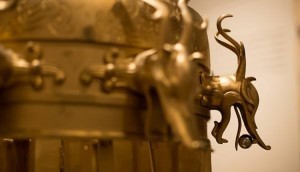The Herakleidon Museum will host the exhibition “Ancient Chinese Science and Technology” of the China Museum of Science and Technology in Beijing introducing to the Greek public for the first time some of the remarkable technological achievements of the Chinese civilization, one of the most ancient. These achievements cover a broad scientific spectrum, from astronomy and navigation to weaving techniques, papermaking, printing, seismography, et al., and will be presented through the models of a variety of inventions. Exhibits are supported by video-installations and all accompanying texts are trilingual (Greek-English-Chinese).
Moreover, visitors will have the unique opportunity to watch the following demonstrations:
– Papermaking: This presentation will allow the audience to understand the papermaking process, an epoch-making invention in the history of human civilization.
– Printing hands-on demonstration: Visitors can experience traditional Chinese printing by using wooden movable types, rubbing and stamping.
– Rubbing: The audience will be introduced to the ancient Chinese rubbing technique, created by placing a piece of paper over the subject and then rubbing the paper.
– Weaving game for childred, to introduce them to the technique of weaving in a simplified way.
– Dougong/Luban Lock/Ball-shaped Luban Lock: This complex jumble of wooden brackets known as “dougong” (11th cent.-256 BC) is one of the outstanding features of traditional Chinese architecture, designed to absorb the earthquake energy.
– Dragon Wash Basin: These folk amusement articles were especially made for the Imperial Court (10th-13th cent AD), as their dragon pattern on the interior suggests.
Chinese civilization, one of the most ancient in the world, has many remarkable achievements to offer in the area of the physical sciences and mechanical engineering. Chinese scientific discoveries and technological inventions cover almost the whole spectrum of the sciences, from mathematics, physics, mechanical engineering and astronomy, to geophysics, biology, botany, medicine, pharmaceutics, chemistry, et al. The ancient Chinese scientists were the first to observe the sunspots, they researched magnetic phenomena, but also calculated, as did the ancient Greeks, the value of π – the ratio of the circumference to the diameter of a circle. The compass, gunpowder, paper, moveable type, bronze and iron casting, the seismograph, crossbow, iron plowshare, wheelbarrow, and the stern rudder are some of the technological achievements of China.
The main thematic units will be:
Astronomy and Time Measurement
The Chinese have always been great astronomers and skilled technicians of astronomical instruments. As early as the 16th century B.C., they were studying the comets, meteors, sunspots, constellations, the sun and the moon. Their calendar is considered a unique combination of the lunar and the Gregorian calendar.
Navigation and Orientation
The compass, one of the most important inventions of the ancient Chinese civilization, was widely used for navigation as early as the Song (960-1279 A.D.) and the Yuan (1271-1368 A.D.) dynasties and spread to Asia and Europe in the 12th century, contributing decisively to the development of trade, finance and culture.
Weaving and Embroidery
China was the first country in the world to practice sericulture systematically, producing silk 6.000-7.000 years ago. As early as the 16th cent. B.C., it developed innovative weaving methods and from the Han dynasty (206 B.C.-220 A.D.) through the Tang dynasty (618-907 A.D.), the famous Chinese silk spread throughout Europe, indelibly marking world culture.
Papermaking and Printing
Papermaking during the Han dynasty is one of the most important inventions of ancient Chinese civilization, as are the numerous printing techniques that were first developed in the 7th cent. A.D., subsequently spreading in Arabia and from there to Africa and Europe, forever changing the history of world culture.
The exhibition will also present models of various other important Chinese inventions, such as the first seismograph (132 A.D.), ancient farming tools (i.e., the ancient Chinese plow that first appeared 5000 years ago), the forerunner of the odometer, the first wheelbarrow, which was constructed a century, approximately, before the equivalent European one, and others.
The exhibition will run to April 29, 2018.
Ask me anything
Explore related questions





